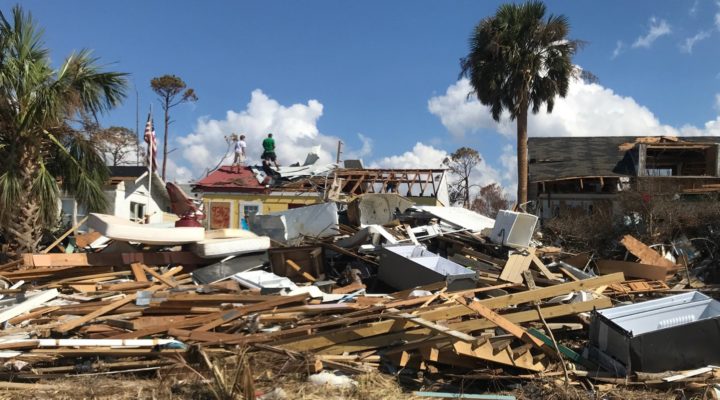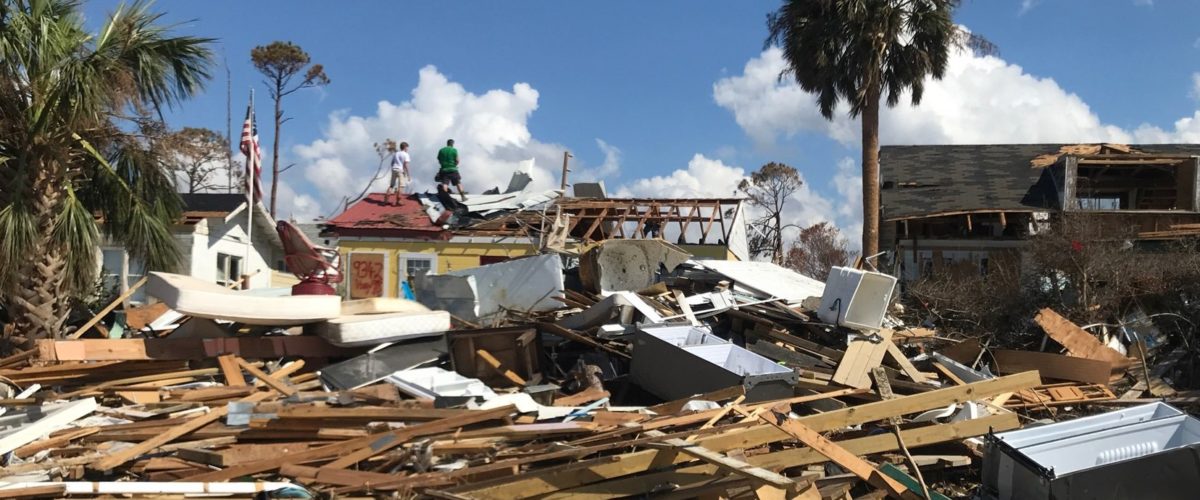Denizens of the Gulf Coast are known as much for their healthy respect for hurricanes as they are for their disdain for evacuating them.
Hurricane Michael has destroyed that attitude.
“From now on they only have to say there is a tropical storm and I will be leaving,” Charles Gunter, a resident of Panama City, Florida, said a few days after narrowly surviving the storm with this wife, Donna.
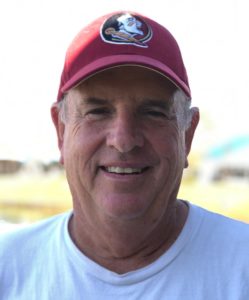
Charles Gunter
Michael, with its destructive storm surge and 155-mph winds, made landfall Wednesday, Oct. 10 in Bay County, Florida, home to the likes of Mexico Beach, Tyndall Air Force Base and Panama City. Only two days earlier, locals shopping for hurricane supplies at the Target store were sharing confidently about their plans for riding out the storm.
“People were talking with one another, saying it’s another one of those drills,” said Gunter, 63.
They didn’t waver in the coming hours as weather forecasters reported Michael’s wind speeds were rising.

Hurricane Michael makes landfall on the Florida Panhandle Oct. 10. (Photo/NOAA/Creative Commons)
“Even with a (Category) 3 heading for Bay County, those of us who had been there forever weren’t that concerned.”
The Gunters had been in Bay County more than three decades. They raised a family, became longstanding members of Hiland Park Baptist Church, and were enjoying retirement.
Yet neither Gunter nor the others at Target that Monday had any idea that everything they had learned from previous storms would become obsolete just 48 hours later.
Florida Panhandle: ‘Those places are just gone’
Looking at the devastation wrought by Hurricane Michael baffles even the most veteran of Gulf Coast residents and disaster-responders still sifting through the debris left behind.
“I don’t think Katrina holds a candle to this,” said Kenny Phillips, founder of Give Me Shelter Ministries, during a recent tour of Mexico Beach and the surrounding areas clobbered by the storm.

Kenny Phillips
Phillips is a carpenter and builder whose ministry focuses on global disaster response. He is based in Fort Walton Beach, Florida, where he also serves as a church planter for the Cooperative Baptist Fellowship.
CBF Florida has turned to Phillips and his ministry to guide its immediate and long-term disaster response.
The tragic scope of Michael’s impact influenced Phillips’ unusual decision to take on a domestic project. He could not ignore how communities like Port St. Joe, Lynn Haven, Panama City and Mexico Beach have been ravaged.
“Those places are just gone,” Phillips said. “You’re probably looking at a 10-year recovery process.”
Panama City: ‘Unlike anything we had ever seen’
That fact was unimaginable to long-time Panama City residents before Hurricane Michael made landfall, Gunter said. But troubling signs began emerging earlier in the day.
“My wife and I at 8 o’clock that morning sat down and were watching the news and they were saying it’s a (Category) 4. And we said, ‘that’s alright.’”
But by 11 a.m., with winds at 60 mph and climbing, Gunter said he was losing confidence in that assessment. The clock-like weather station on his back porch showed an alarming drop in barometric pressure. Winds started hitting 80 mph. Friends and family were texting and calling.

A damaged home between Port St. Joe and Mexico Beach. (Photo/Rachel Gunter Shapard)
“At 87 mph my weather station left, just blew away,” Gunter said. Electricity vanished as trees and power lines snapped like match sticks.
“My wife and I said this was unlike anything we had ever seen.”
From around noon onward, the couple knew they had made a mistake staying home. Previous visitors like Hurricanes Eloise (1975), Elena (1985), Opal (1995) and Ivan (2004) didn’t come close the terror Michael was delivering to Bay County, Gunter said.
Michael is being called the the strongest storm to hit Florida in 100 years.
“The noise was unlike anything I had ever been through before. It was deafening.”
White-out conditions made the windows useless.
“We had no idea what was happening outside,” he said.
But for the Gunters, it was about to get worse. Michael, no longer satisfied with outside destruction, was trying to come indoors.
Hopeful, Georgia: ‘It’s just chaos, really’
The storm’s violence was just as mind-blowing on a mass scale as it was at the Gunter home. At least 30 people have been reported killed, at least 1,100 missing and more than 124,000 without power in Florida and Georgia. Today, two weeks since Michael, the damage is still being assessed.

Reggie Bostick
And there’s the economic impact. It’s estimated to be around $3 billion in Georgia alone.
The folks in tiny Hopeful, Georgia, sadly can claim their part of that dismal economic reality.
“If you blink your eyes you’ll already be through Hopeful,” farmer Reggie Bostick said of the unincorporated rural community located about 55 miles north of Tallahassee, Florida.
Thanks to Michael, there’s even less to see.
The cotton crops, pecan trees and poultry operations owned and operated by many of its residents have been wiped out, Bostik said.
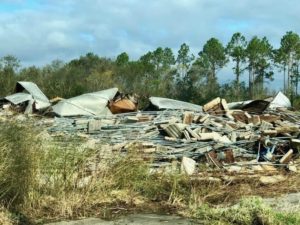
A flattened structure in Hopeful, Georgia.
“I lost two poultry houses and I grew cotton. The cotton was blown right out of the ground,” he said. “Our economy was damaged real bad. It’s going to take years” to recover.
Most homes in the community were only lightly damaged, but the only house of worship – Hopeful Baptist Church – took a pounding and is partially unusable, said Bostik, the congregation’s chairman of deacons.
“Everybody has trees down and damaged vehicles. Everybody is affected,” he said.
But neighbors are rallying to help each other. The community is pitching in to help local peanut growers harvest crops amid the damage.
“I have never experienced anything like this in my lifetime and talking with some of the elders of our community, they have never witnessed anything like this in their lifetime,” he said. “Right now, it’s just chaos, really.”
Panama City: ‘The neighborhood was in shambles’
For the Gunters, that chaos was palpable as Michael slammed their county and neighborhood. Concern shifted into fear as the storm tried to force its way into their home.
“We started noticing water was being blown through the seals of the windows,” Gunter said.

A wrecked room inside the Gunter home in Panama City, Florida. (Photo/Courtesy of LeAnn Gunter Johns)
As the couple busily mopped puddles, they heard part of the house groaning and cracking.
“Then we lost our porch. It just took it like it was twigs and the porch flew away.”
The threat increased when a 70-pound chunk of concrete – the first of three – smashed into the roof.
“That’s when the rain started coming through the ceiling space, which began collapsing,” Gunter said.
It got worse from there.
More and more sections of ceiling began imploding under the force of wind and water, driving the couple from room to room in search of relative safety.
“Our house was literally breaking down in pieces and we didn’t know what to do.”
What they did, when there seemed to be a lull in Michael’s attack, was run across Marin Drive to a neighbor’s home. They banged on the door and were greeted by a neighbor just as shell-shocked as they were.
Once inside, Gunter recalled the gauntlet of disturbing sights he and Donna had witnessed during the escape.
“The water in the street was literally knee deep,” he said. “The neighborhood was in shambles.”
Mexico Beach: ‘They salvaged a soup pot’
Sometimes, tragedy is measured on a mass scale. For John McClellan and his family, it boiled down to a single soup pot.
The Rome, Georgia, resident married into a family that owned a vacation home in Mexico Beach, Florida. It was the place of summer vacations and winter breaks, of Thanksgiving and Christmases.
“It became the place for all four children and their spouses, the 15 grandchildren and I couldn’t tell you how many great-grandchildren,” said McClellan, a deacon at First Baptist Church in Rome, Georgia. It was a very special place to his own children, too.
“They grew up going to Mexico Beach. That’s where they learned to love the beach, to collect shells and to visit their favorite place for ice cream.”
Thanks to Michael, only the memories remain. Everything else is gone.
Except for that one kitchen item.
“They salvaged a soup pot,” McClellan said. “My mother-in-law had it for years. But there is nothing left of the house.”
Panama City: Sustained by faith
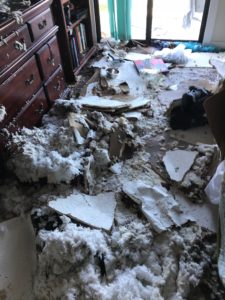
Michael’s impact inside the Gunter home in Panama City. (Photo/Courtesy of LeAnn Gunter Johns)
As the situation in the Gunter home deteriorated, and even after they abandoned it, there were long moments when the only action to take was to pray.
“Praying without ceasing was certainly on my mind at the time,” Gunter said.
He praised his wife for having a much deeper peace about her throughout the ordeal — even as those other two concrete chunks and a huge wooden beam crashed into the home.
“We prayed. My wife was praying. She was the stronger person. She was a whole lot stronger than I was,” he said.
Gunter said he was especially comforted by recalling Scripture passages about Peter walking on water toward Christ’s outstretched hand, and of Jesus calming storms.
“As we went through this terrible experience, we knew God was with us,” he said.
Port St. Joe: Houses covered in seaweed
A few miles down U.S. 98 from Panama City, Mexico Beach has become the international face of Michael’s destruction. Images evoke scenes from war-torn Syria. Entire blocks, block after block, are flattened.
No wonder. The storm used 155-mph winds and flooding close to 10 feet to smash the tight-knit beach community.
Half a month later, relief operations are still in the first-responder phase in many areas. Missing people are being searched for. Some roads, and entire neighborhoods, are inaccessible. Thousands are without power and entire communities have no running water.
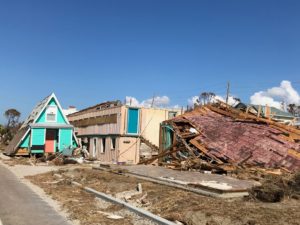
Smashed buildings on U.S. 98 between Port St. Joe and Mexico Beach. (Photo/Rachel Gunter Shapard)
But moving in and out of those ravaged spaces, along with rescuers, are faith-based groups like CBF and its Florida and Georgia disaster response leaders. They have spent recent days working through local churches to find where their help is needed most.
In Florida, CBF teams have delivered a shower trailer to Mexico Beach, where the tower-based water supply was wiped out. It’s there to serve first-responders, initially, then the entire community. They have also delivered a trailer containing chainsaws, muck-out supplies and other recovery tools to Port St. Joe.
But the main goal is to establish bases of operation for CBF’s expertise in long-term recovery.
“In the next month or so we’ll start identifying some of the places where we want to provide more long-term assistance for some of the more vulnerable communities,” said Ray Johnson, coordinator of CBF Florida.
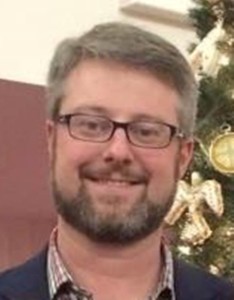
John Uldrick
Individual congregations also are gearing up to help in both the Peach and Sunshine states.
First Baptist Church in Rome, Georgia, has been active identifying needs in its own state and in Florida, said John Uldrick, the minister for students and missions.
“FBC Rome will respond,” Uldrick said via Facebook Messenger. “We have a member who lost a vacation home and we have a different member in Hopeful, GA, who had some damage to homes and to their small church.” They will respond to other communities, as well.

Rachel Gunter Shapard
Rachel Gunter Shapard, the associate coordinator of CBF Florida, recently toured the Panhandle to identify needs and likely bases of operation. It was a difficult job because of the widespread nature of the damage.
“There was a gentleman in Mexico Beach who works for FEMA, whose first hurricane was Andrew (1986),” said Shapard, who is not related to the Gunters. “He said even Andrew doesn’t compare to this one in terms of total devastation.”
Shapard said she was astonished by some of the bizarre ways the storm affected the coast.
“Between Port St. Joe and Mexico Beach, all those homes right on the beach had seaweed on the roofs,” she said. “We’re talking homes three stories tall on stilts with seaweed on the roofs.”
Panama City: ‘The whole area needs prayer’
When Michael had finally passed through, the Gunters and the rest of Bay County were greeted with devastation too great to comprehend.
“There was so much hurt, so much destruction around us,” Gunter said.
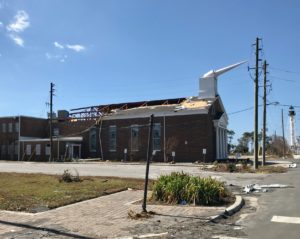
Heavy damage to First Baptist Church of Port St. Joe, Florida. (Photo/Rachel Gunter Shapard).
The Panama City the Gunters had known for 35 years is gone. Familiar landmarks have been erased, making it awkward to navigate by car or foot. Favorite restaurants were destroyed. Entire apartment complexes, once housing hundreds of people, have been wiped out.
“Hundreds and thousands of income-based apartments are gone,” he said.
Even nature was damaged.
“The landscape has totally changed. Seventy-five to eighty percent of our trees are gone. There are no trees.”
Churches, including the Gunters’ Hiland Park Baptist Church, got whacked, too.
“Ninety-nine percent of our churches will be meeting in their parking lots for a month if not four or five months,” he said.
The experience during and after the storm has inflicted significant emotional trauma. Gunter said he hasn’t slept restfully since Michael. He and his wife have spent time afterward at a daughter’s home in Macon, Georgia, to temporarily escape the depressing visuals the hurricane left behind.
“I think PTSD is very real. My wife and I, our nerves are on edge,” he said. “Bay County will never be the same.”
Even so, Gunter said there is much to be thankful for.
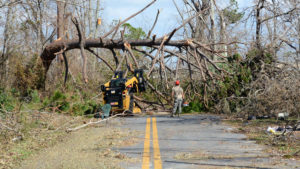
Hurricane Michael continues to torment the Florida Panhandle and southern Georgia — even two weeks after it made landfall. (Photo/Florida National Guard/Creative Commons)
For Gunter, that includes the safety of one of his daughters, her husband and children who rode out the storm in a newer home about a mile away. They sustained relatively light damage.
Another gratitude is that no one in his own neighborhood was hurt.
And the experience has drawn neighbors together in unusual and inspiring ways – especially in a community governed by a homeowners’ association.
“People have been going door to door checking on people, sharing whatever they have,” he said. “It doesn’t matter if you keep up with HOA rules, we have to take care of each other. Things like this show that.”
Plus, they have places to stay until their home can be rebuilt.
What they still need — what everyone needs — is spiritual support.
“People need prayer,” he said. “The whole area needs prayer.”
Individuals and congregations interested in contributing time or funds to Hurricane Michael relief can register and donate online at CBF Disaster Response.

